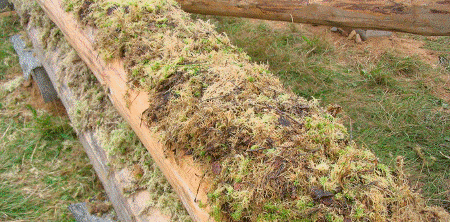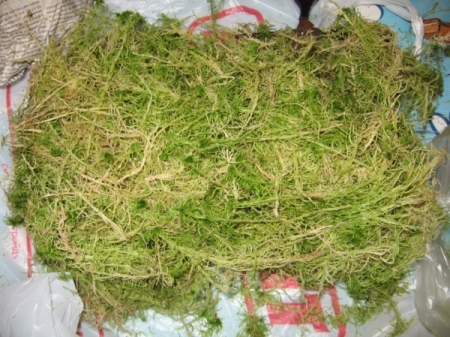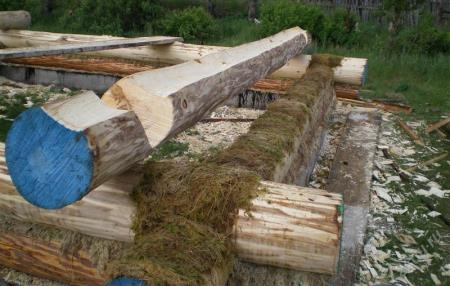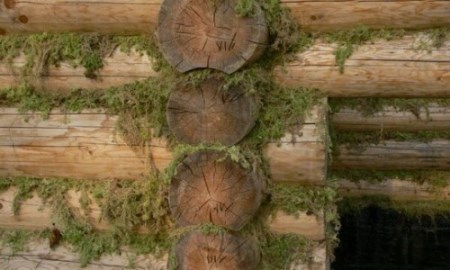Despite the abundance of synthetic heat insulators, natural materials are the best choice for a wooden house. Moss in the construction of log cabins is still widely used due to its unique insulating and antibacterial properties.

Moss selection
In Belarus, there are two varieties of mosses that differ in appearance and performance characteristics of sphagnum and cuckoo flax.
Sphagnum
Sphagnum, or white moss, as it is also called, is found in coniferous forests and wetlands. The plant has a long pile – green at the top, and whitish at the bottom. The roots are short and unbranched (after dying off, they turn into peat), so the collection of the tops is not difficult.
White moss is hygroscopic, not very durable. To insulate a log house, the material must be bought with a margin, since when it dries it greatly decreases in volume. With prolonged use, sphagnum caulk crumbles.

Kukushkin flax
It grows in the lower reaches, on forest edges, in swamps. The plant got its name for its external resemblance to flax: it has tall reddish stems with bright inflorescences. Unlike white, red moss is more reliable and durable as a heater for wooden structures. It is dense, elastic, absorbs little moisture.

Pros and cons of moss insulation
Building moss for a log house is more effective than another natural material – tow. It cannot evenly fill the gaps between the crowns, which is why the tree wears out faster under the influence of external factors. The tow is often pulled out by birds and small rodents to arrange nesting sites.
Moss in the construction of log cabins is preferable due to a number of advantages over other heaters:
- thanks to long fibers, it easily gathers into dense bundles, is convenient to work with;
- environmentally friendly, does not contain toxic additives, smells good;
- due to the antiseptic component (sphagnol) protects the tree from parasitic organisms;
- absorbs moisture well and quickly evaporates it if it gets wet, preventing the appearance of fungus and rotting of logs;
- retains heat well and at the same time provides wall air exchange.
Moss also has its drawbacks. It is difficult to find it on the market, and collecting and drying it yourself is a rather laborious process.
Preparation of moss for mezhventsov warming
The quality of thermal insulation largely depends on the conditions for the procurement of raw materials. Both types of moss are harvested in the fall, when there are not many snails and insects in the plant material.
- For sphagnum, the optimal harvest time is a clear sunny day. With a loss of moisture, its thermal insulation properties do not deteriorate, so it is not afraid of bright rays.
- It is advisable to collect red moss for situs judi slot pulsa terbaik dan terpercaya no 1 a log house in cloudy weather, as it is sensitive to ultraviolet light. It is better to harvest raw materials not in a swamp, but in a forest area, under trees: there the moss is less wet and dries out faster in the future.

Construction moss drying rules
To prevent the collected moss from becoming moldy, it is sieved to remove soil, leaves and extraneous plants are selected. After that, the material dries naturally within 1-3 weeks, depending on the degree of humidity.
- Kukushkin flax for drying is laid out in a continuous strip on any base. Ready-made red moss, like a roll-type insulation, is laid between the crowns of a log house.
- Sphagnum is laid in small bunches so as not to disturb its fragile structure.
If the drying technology is followed, dry moss twists into a bundle, but does not break. The finished insulation is collected in bags.
Laying insulation when assembling a log house
To make the dried material more pliable and easier to take the shape of a groove, after unpacking it is folded into a stack and periodically sprinkled with water from a spray for two days. Caulking a log house with moss has its own characteristics, taking into account the type of plant raw materials.
- Bunches of sphagnum are gently fluffed up with your hands and give them the consistency of cotton wool. Next, white moss is evenly distributed over the crown, placing the stems perpendicular to the logs.
- Each next bunch is laid with an overlap in relation to the previous one, so that the row is dense.
- Ribbons of red moss are placed across the logs, also maintaining an overlap.
- The layer thickness should be at least 10-15 cm.
- At the joints of the logs, the insulation is mounted, releasing it along the edge by 40 mm, and between the tiers the moss should hang by at least 10 mm. In the future, the edges are folded over and the seams are sealed.

Major mistakes
They often ask how to caulk a log house correctly so that the moss performs its functions as efficiently as possible. Here is a list of mistakes to avoid when insulating.
- The appearance of cracks. The larger the diameter of the logs, the more material will have to be laid, since under the weight of the next crown the moss is strongly crumpled.
- Blowing out the seams. Even if the amount of insulation is sufficient, it is necessary to carefully carry out additional caulking with folded edges.
- Rotting logs. Despite the breathable properties of moss, the logs are impregnated with antiseptics before installing the frame to ensure the safety of the wood at high humidity.

Building moss for a log house has many advantages in comparison with other analogues. The collection, preparation and installation of natural material have certain nuances, therefore, for competent insulation of a wooden house, it is worth hiring professionals, gradually controlling the construction of a log house and its insulation.